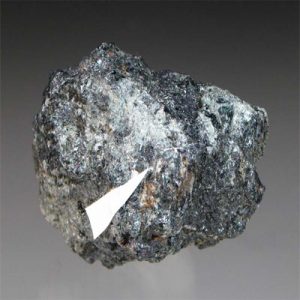Bromellite
Bromellite is an extremely rare gem, possibly the rarest gemstone in existance. At this time only 17 faceted Bromellite gems are known to exist. One colorless Bromellite crystal was found near Gilmala, Ratnapura, Sri Lanka in March 1999. It was cut into 17 faceted gems. The largest 3 of the 17 gems weighed 2.80 ct, 1.92 ct and 0.68 ct. The remaining 14 gems were all below 0.50 ct in weight. The picture above is of a 0.41 ct Bromellite gem that was one of the original 17 Bromellite gems (photo courtesy of Murray Burford – sinhalite.com). This one crystal is the only known gem quality crystal to be found to date. Gems & Gemology has described the three largest stones cut from the Sri Lanka crystal in the Fall 2002 issue, V.38 N.3 pages 250-251. Very small Bromellite crystals have also been found in the Ural mountain area of Russia, but these are all far too small to be faceted.
Bromellite is an interesting mineral in that it is a simple oxide, similar to Periclase (MgO), Tenorite (CuO) and Zincite (ZnMnO), and consists only of beryllium and oxygen (BeO). It has a Mohs hardness of 9 but a molecular weight of only 25.01 gm. Synthetic Bromellite crystals were made by the flux method in the 1960’s by Rockwell International of California. Their proposed use was as heat sinks for semiconductors in electronics. Synthetic Bromellite has a thermal conductivity higher than Gold and close to that of Copper and could be confused with Diamond when using a thermal tester.
Bromellite was first described in 1925 by Swedish scientist and artist Gregori Aminoff (1883-1947) from skarn-like deposits in Långban, Filipstad, Värmland, Sweden. Bromellite was named to honor Swedish physician and paleontologist Magnus Bromelius, ennobled as von Bromell, (1679-1731). According to Swedish botanist and mycologist Elias Magnus Fries (1794-1878), von Bromell was the first Swede to describe plant fossils. Particularly noteworthy among von Bromell’s scientific work is the “Lithographiae Suecanæ Specimen Secundum” in 1727, considered one of the first scientific works devoted exclusively to Swedish fossil and mineral finds. Also, in a geological treatise, von Bromell proposed a classification of minerals according to their chemical composition.
Bromellite distribution: the only location known for a (only one) gem quality natrual crystal is near Gilmala, Ratnapura, Sri Lanka. Non gem quality crystals are found at these localtions: Långban, Värmland, Sweden. In the Saga larvikite quarry, Tvedalen, near Larvik, Norway. From the Izumrudnye district, Yekaterinburg (Sverdlovsk), Ural Mountains, the Pitkäranta district, Lake Ladoga, Karelia, and other less-well-defined localities in Russia.
| Chemical Formula: | BeO |
| Beryllium Oxide | |
| Molecular Weight: | 25.01 gm |
| Composition: | Beryllium | 36.03 % | Be | 100.00 % | BeO |
| Oxygen | 63.97 % | O | |||
| 100.00 % | 100.00 % | = TOTAL OXIDE |
| Crystallography: | Hexagonal – Dihexagonal Dipyramidal |
| Crystal Habit: | As prismatic crystals, elongated along [0001], to 1 mm, showing pyramidal hemimorphism, with {0001} and {1010} well developed, {1011} small; may be tabular || {0001}; in randomly intergrown rosettelike aggregates; cleavage fragments, to 10 cm. |
| Twinning: | None |
| Cleavage: | Distinct on {1010} |
| Fracture: | None |
| Tenacity: | Brittle |
| Moh’s Hardness: | 9.0 |
| Density: | 3.01 – 3.03 (g/cm3) |
| Luminescence: | Fluorescent; fluoresces yellowish white in both LW and SW UV; may also display weak orange under SW UV. |
| Radioactivity: | Not Radioactive |
| Other: | Pyroelectric |
| Color: | White to creamy White, Colorless |
| Transparency: | Transparent to Translucent |
| Luster: | Vitreous |
| Refractive Index: | 1.719 – 1.733 Uniaxial ( + ) |
| Birefringence: | 0.0140 |
| Dispersion: | Strong to moderate; r > v or r < v |
| Pleochroism: | None |


